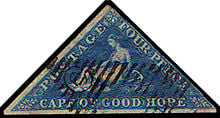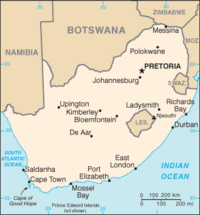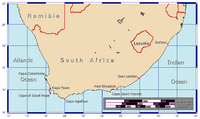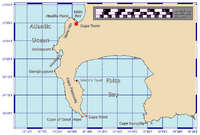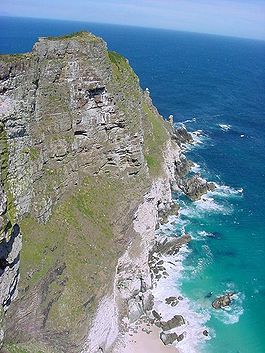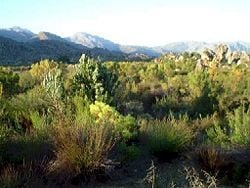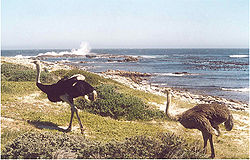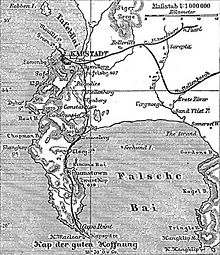Difference between revisions of "Cape of Good Hope" - New World Encyclopedia
Mary Anglin (talk | contribs) |
Mary Anglin (talk | contribs) |
||
| Line 14: | Line 14: | ||
[[Image:CapeHopeOverview.png|thumb|right|200px|Map showing the locations of the Cape of Good Hope and [[Cape Agulhas]].]] | [[Image:CapeHopeOverview.png|thumb|right|200px|Map showing the locations of the Cape of Good Hope and [[Cape Agulhas]].]] | ||
[[Image:CapeHopePeninsulaMap.png|thumb|right|200px|Map showing the [[Cape Peninsula]], illustrating the positions of the Cape of Good Hope and [[Cape Point]]]] | [[Image:CapeHopePeninsulaMap.png|thumb|right|200px|Map showing the [[Cape Peninsula]], illustrating the positions of the Cape of Good Hope and [[Cape Point]]]] | ||
| − | [[Image:Satellite image of Cape peninsula.jpg|thumb|right|250px|[[Landsat]] Image over [[SRTM]] Elevation, showing the Cape Peninsula in the foreground. [http://photojournal.jpl.nasa.gov/catalog/PIA04961 Image credit: NASA/JPL/NIMA]]] | + | [[Image:Satellite image of Cape peninsula.jpg|thumb|right|250px|[[Landsat]] Image over [[SRTM]] Elevation, showing the Cape Peninsula in the foreground. [http://photojournal.jpl.nasa.gov/catalog/PIA04961 Image credit: NASA/JPL/NIMA].]] |
[[South Africa]] is located at the southernmost region of [[Africa]], with a long coastline that stretches more than 1,550 mi (2,500 km) and across two [[ocean]]s, (the [[Atlantic Ocean|Atlantic]] and the [[Indian Ocean|Indian]]). | [[South Africa]] is located at the southernmost region of [[Africa]], with a long coastline that stretches more than 1,550 mi (2,500 km) and across two [[ocean]]s, (the [[Atlantic Ocean|Atlantic]] and the [[Indian Ocean|Indian]]). | ||
Revision as of 04:25, 12 February 2009
The Cape of Good Hope (Afrikaans: Kaap die Goeie Hoop, Dutch: Kaap de Goede Hoop, Portuguese: Cabo da Boa Esperança) is a rocky headland on the Atlantic coast of South Africa. There is a very common misconception that the Cape of Good Hope is the southern tip of Africa and the dividing point between the Atlantic and Indian Oceans, but in fact the southernmost point is Cape Agulhas, about 150 kilometres (90 mi) to the southeast. However, when following the coastline from the equator, the Cape of Good Hope marks the psychologically important point where one begins to travel more eastward than southward. Thus the rounding of the cape in 1488 was a major milestone in the attempts by the Portuguese to establish direct trade relations with the Far East.
As one of the great capes of the South Atlantic Ocean, the Cape of Good Hope has been of special significance to sailors for many years and is widely referred to by them simply as The Cape.[1] It is a major milestone on the clipper route followed by clipper ships to the Far East and Australia, and still followed by several offshore yacht races.
The term "Cape of Good Hope" was also used to indicate the early Cape Colony established in 1652, in the vicinity of the Cape Peninsula. Just prior to the formation of the Union of South Africa, the term referred to the entire region that was to become the Cape Province in 1910.
"The legendary Cape Point and Cape of Good Hope form part of the Nature Reserve. These promontories were key beacons for the early explorers and are the source of many myths and legends. In 1488, Bartholomew Dias named the Peninsula Cabo Tormentoso, or the Cape of Storms. King John II of Portugal later gave it the name Cabo da Boa Esperanca - the Cape of Good Hope. In 1580, Sir Frances Drake proclaimed it to be ' … the most stately thing and the fairest Cape we saw in the whole circumference of the earth.'...In the 17th century a Dutch Captain, Hendrick van der Decken, attempted to round the Cape in strong headwinds. Mysteriously his ship and crew disappeared, and legend now tells of the ghost ship "The Flying Dutchman", which has allegedly been sighted around Cape Point."
Geography
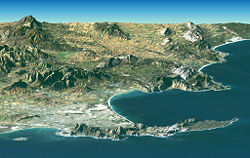
South Africa is located at the southernmost region of Africa, with a long coastline that stretches more than 1,550 mi (2,500 km) and across two oceans, (the Atlantic and the Indian).
The Cape Peninsula is a generally rocky peninsula that juts out for 75 km (47 mi) into the Atlantic at the southwestern extremity of the continent. At the southern end of the peninsula are the Cape of Good Hope, and about 2.3 kilometers (1.4 mi) to its east is Cape Point. Cape Town is about 50 kilometers to the north of the Cape, in Table Bay at the north end of the peninsula. The famous Table Mountain overlooks Cape Town. The peninsula forms the western boundary of False Bay.
The Cape of Good Hope is sometimes given as the meeting point of the Atlantic Ocean and Indian Ocean. However, according to the International Hydrographic Organization agreement that defines the ocean boundaries, the meeting point is at Cape Agulhas, about 200 km (120 mi) to the southeast. [1]
Geologically, the rocks found at the two capes - and indeed over much of the peninsula - are part of the Table Mountain Group, and are formed of the same type of sandstone as those exposed in the faces of Table Mountain itself.
The term Cape of Good Hope has also been used in a wider sense, to indicate the area of the early European colony in the vicinity of the cape.[2]
National park
Both the Cape of Good Hope and Cape Point offer spectacular scenery. The whole of the southernmost portion of the Cape Peninsula is the wild, rugged, scenic and generally unspoiled Table Mountain National Park. The park runs approximately north-south along the range of mountains that make up the mountainous spine of the Cape Peninsula, from Signal Hill in the north, through Lion's Head, Table Mountain, Constantiaberg, Silvermine Nature Reserve, the mountains of the southern Peninsula, and terminates at Cape Point.
The park is not a single contiguous area; the undeveloped mountainous areas which make up most of the park are separated by developed urban areas on shallower terrain. Thus the park is divided into three separate sections. The section that covers the southernmost area of the Cape Peninsula stretches from Cape Point and the Cape of Good Hope in the south, as far north as Scarborough on the Atlantic coast and Simon's Town on the False Bay coast. It was formed from the Cape of Good Hope Nature Reserve.
The South African Marine Living Resources Act is strictly enforced throughout the Table Mountain National Park, and especially in marine protected areas. Disturbance or removal of any marine organisms is strictly prohibited between Schusters Bay and Hoek van Bobbejaan, but is allowed in other areas during season and with relevant permits.
Plant and animal life
With its diverse habitat, ranging from rocky mountain tops to beaches and open sea, the Cape of Good Hope is home to at least 250 species of birds.
"Bush birds" tend to be rather scarce because of the coarse, scrubby nature of fynbos vegetation. When flowering, however, proteas and ericas attract sunbirds, sugarbirds, and other species in search of nectar. For most of the year, there are more small birds in coastal thicket than in fynbos.
Large animals are a rare sight in the Cape of Good Hope, but there are a wealth of small animals such as lizards, snakes, tortoises and insects. There are some herds of zebra, eland and a variety of other antelope. Small mammals include rock hyrax (dassie), striped mouse, water mongoose, Cape clawless otter and white deer. Baboons also inhabit the area.
The area offers excellent vantage points for whale watching. The Southern right whale is the species most likely to be seen in False Bay between June and November. Other species are the Humpback whale and Bryde's whale. Seals and Dusky Dolphins or Orca, the Killer Whales may also be seen.
The strategic position of the Cape of Good Hope between two major ocean currents, ensures a rich diversity of marine life. There is a difference between the sea life west of Cape Point and that to the east due to the markedly differing sea temperatures.
The Cape of Good Hope is an integral part of the Cape Floristic Kingdom, the smallest but richest of the world's six floral kingdoms. This comprises a treasure trove of 1,100 species of indigenous plants, of which a number are endemic. Two types of fynbos ("fine bush"), coastal fynbos on alkaline sands and inland fynbos on acid soils, are found.
Characteristic fynbos plants include proteas, ericas (heath), and restios (reeds). Some of the most striking and well-known members belong to the Proteacae family, of which up to 24 species occur. These include King Protea, Sugarbush, Tree Pincushion and Golden Cone Bush.
Many popular horticultural plants such as pelargoniums, freesias, daisies, lilies and irises also have their origins in fynbos.
History
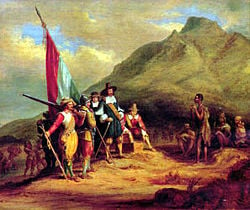
Stone Age hunter-gatherers who used stone tools and fire arrived in the Western Cape area around 100,000 B.C.E. They survived the Ice Age, when water levels were around 120 meters lower than their current levels. Fossils indicate that by 8000 B.C.E., the inhabitants had developed bows and arrows for hunting. Nearly 6,000 years later, a large migration of tribes further inland brought contact with skilled agriculturalists, prompting cape inhabitants to grow crops.
Some speculate that before European explorers reached the Cape of Good Hope, Chinese, Arabian, or Indian explorers/merchants may already have visited it, and kept records of these visits. The Old World maps such as Kangnido and Fra Mauro map made before 1488 may be evidence of this.
The Khoikhoi were originally part of a pastoral culture and language group found across Southern Africa. Originated in the northern area of modern Botswana, the ethnic group steadily migrated south, reaching the Cape approximately 2,000 years ago. Migratory bands of Khoi living around what is today Cape Town intermarried with San peoples. However the two groups remained culturally distinct as the Khoikhoi continued to graze livestock and the San subsisted as hunter-gatherers. The Khoi resided in the Cape area when European explorers and merchants arrived in the fifteenth century. Europeans referred to the Khoikhoi as "Hottentots".
The first circumnavigation of the Cape of Good Hope by Portuguese explorer Bartolomeu Dias occurred in 1488. Along with the accounts of early navigators, the accounts of shipwreck survivors provide the earliest written accounts of Southern Africa. In the two centuries following 1488, a number of small fishing settlements were made along the coast by Portuguese sailors. In 1652 a victualling station was established at the Cape of Good Hope by Jan van Riebeeck on behalf of the Dutch East India Company. For most of the seventeenth and eighteenth centuries, the slowly expanding settlement was a Dutch possession. The Dutch settlers eventually met the southwesterly expanding Xhosa people in the region of the Fish River. A series of wars ensued, mainly caused by conflicting land and livestock interests.
Great Britain seized the Cape of Good Hope area in 1797 seeking to use Cape Town in particular as a stop on the route to Australia and India. The Dutch East India Company declared bankruptcy, and the British annexed the Cape Colony in 1805. The British continued the frontier wars against the Xhosa, pushing the eastern frontier eastward through a line of forts established along the Fish River and consolidating it by encouraging British settlement. Due to pressure from abolitionist societies in Britain, the British Parliament first stopped its global slave trade in 1806, then abolished slavery in all its colonies in 1833.
The area remained under British rule until it was incorporated into the independent Union of South Africa, created from the Cape and Natal colonies, as well as the republics of Orange Free State and Transvaal, on May 31, 1910.
Demographics
Concerns
See also
- Cape Horn, its South American counterpart
- Western Cape
- History of Cape Colony
Notes
- ↑ Along the Clipper Way, Francis Chichester; page 78. Hodder & Stoughton, 1966. ISBN 0-340-00191-7
- ↑ Balson Holdings Family Trust. Cape of Good Hope Land Grants and related histories Retrieved February 11, 2009.
ReferencesISBN links support NWE through referral fees
- Cape Town. Cape of Good Hope Nature Reserve Retrieved February 11, 2009.
- Elbourne, Elizabeth. 2002. Blood ground: colonialism, missions, and the contest for Christianity in the Cape Colony and Britain, 1799-1853. McGill-Queen's studies in the history of religion, 19. Montreal: McGill-Queen's University Press. ISBN 9780773522299
- Hocquard, Emmanuel. 2000. Cape of Good Hope. Los Angeles: Green Integer. ISBN 9781892295408
- Poussin, Alexandre, and Sonia Poussin. 2008. Africa Trek I: from the Cape of Good Hope to Mount Kilimanjaro. Portland, Ore: Inkwater Press. ISBN 1592993575
- Ross, Robert. 1999. Status and respectability in the Cape Colony, 1750-1870: a tragedy of manners. African studies series, [98]. Cambridge, UK: Cambridge University Press. ISBN 9780521621229
- Theal, George McCall. 1969. History of the Boers in South Africa; or, The wanderings and wars of the emigrant farmers from their leaving the Cape Colony to the acknowledgment of their independence by Great Britain. New York: Negro Universities Press. ISBN 9780837116617
- Towards a New Age of Partnership. History of the Cape of Good Hope Retrieved February 11, 2009.
Credits
New World Encyclopedia writers and editors rewrote and completed the Wikipedia article in accordance with New World Encyclopedia standards. This article abides by terms of the Creative Commons CC-by-sa 3.0 License (CC-by-sa), which may be used and disseminated with proper attribution. Credit is due under the terms of this license that can reference both the New World Encyclopedia contributors and the selfless volunteer contributors of the Wikimedia Foundation. To cite this article click here for a list of acceptable citing formats.The history of earlier contributions by wikipedians is accessible to researchers here:
The history of this article since it was imported to New World Encyclopedia:
Note: Some restrictions may apply to use of individual images which are separately licensed.
